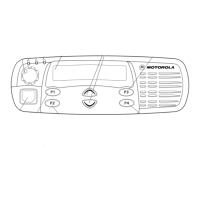UHF Band 1 (403–470 MHz) 25–40 W Bipolar Frequency Synthesis Section 9: 2-5
6881091C63-F
3.7 Harmonic Filter
Inductors L4491, L4492, L4493 and capacitors C4448, C4493,C4494, C4496 and C4498 form a
low-pass filter to attenuate harmonic energy from the transmitter. R4491 is used to drain any
electrostatic charges that might otherwise build up on the antenna. The harmonic filter also prevents
high level RF signals above the receiver passband from reaching the receiver circuits, improving
spurious response rejection.
3.8 Power Control
The transmitter uses the Power Control IC (PCIC, U4501) to control the power output of the radio. A
portion of the forward RF power from the transmitter is sampled by the bi-directional coupler and
rectified, to provide a DC voltage to the RFIN port of the PCIC (pin 1) which is proportional to the
sampled RF power.
The PCIC has internal digital-to-analog converters (DACs) which provide the reference voltage of
the control loop. The reference voltage level is programmable through the SPI line of the PCIC. This
reference voltage is proportional to the desired power setting of the transmitter, and is factory
programmed at several points across the frequency range of the transmitter to offset frequency
response variations of the transmitter’s power detector circuits.
The PCIC provides a DC output voltage at pin 4 (INT) and applied as CNTLVLTG to the power-
adjust input pin of the first transmitter stage U4401. This adjusts the transmitter power output to the
intended value. Variations in forward or reflected transmitter power cause the DC voltage at pin 1 to
change, and the PCIC adjusts the control voltage above or below its nominal value to raise or lower
output power.
Capacitors C4502-4, in conjunction with resistors and integrators within the PCIC, control the
transmitter power-rise (key-up) and power-decay (de-key) characteristic to minimize splatter into
adjacent channels.
U4502 is a temperature-sensing device, which monitors the circuit board temperature in the vicinity
of the transmitter driver and final devices, and provides a DC voltage to the PCIC (TEMP, pin 29)
proportional to temperature. If the DC voltage produced exceeds the set threshold in the PCIC, the
transmitter output power is reduced so as to reduce the transmitter temperature.
4.0 UHF Band 1 (403–470 MHz) 25–40 W Bipolar Frequency
Synthesis
The synthesizer subsystem consists of the reference oscillator (Y4261 or Y4262), the low voltage
fractional-N synthesizer (LVFRAC-N, U4201), and the Voltage Controlled Oscillator VCO.
4.1 Reference Oscillator
The reference oscillator (Y4262) contains a temperature compensated crystal oscillator with a
frequency of 16.8 MHz. An analog-to-digital (A/D) converter internal to U4201 (LVFRAC-N) and
controlled by the µP via serial interface (SRL) sets the voltage at the warp output of U4201, pin 25 to
set the frequency of the oscillator. The output of the oscillator (pin 3 of Y4262) is applied to pin 23
(XTAL1) of U4201 via an RC series combination.

